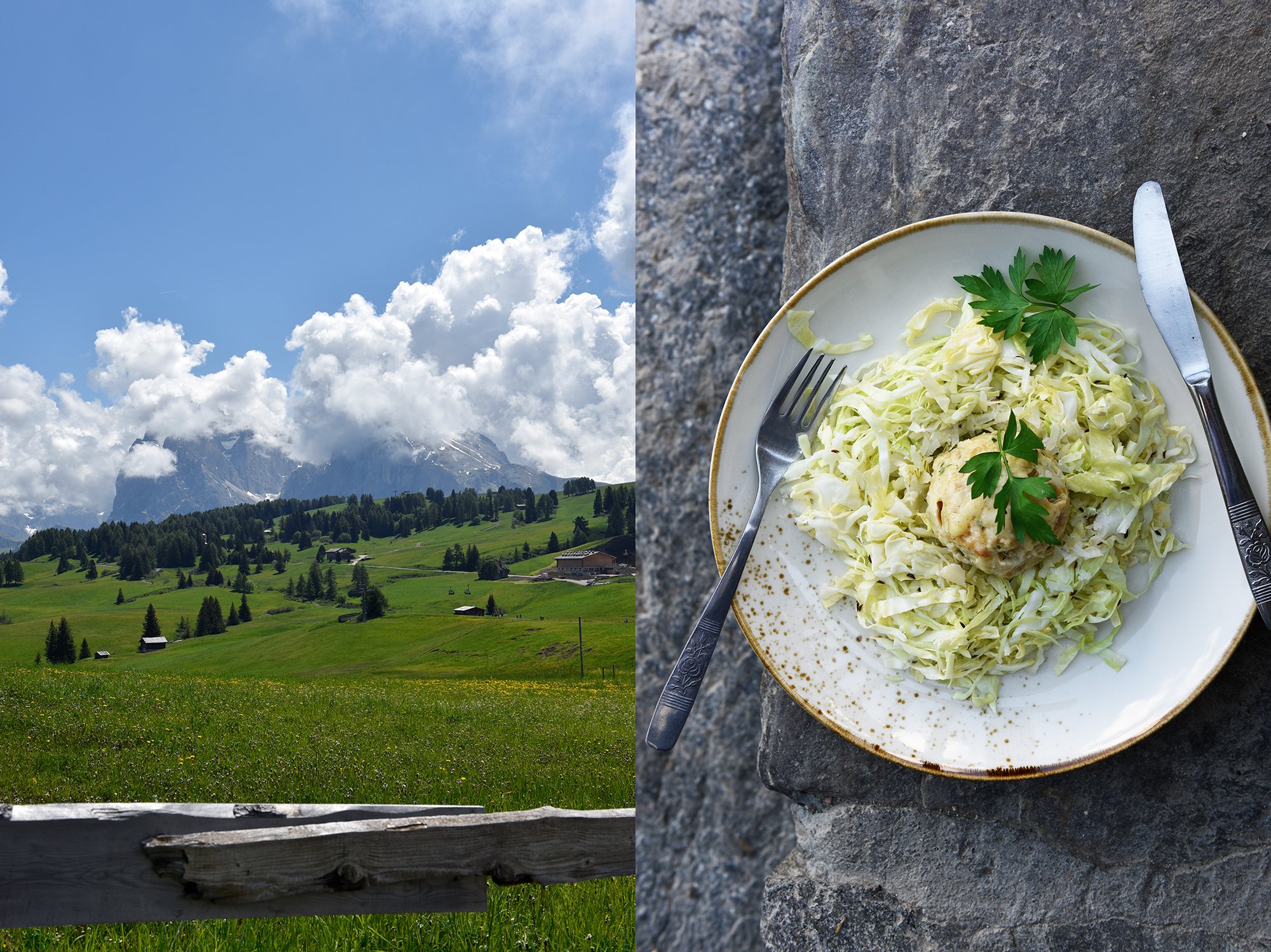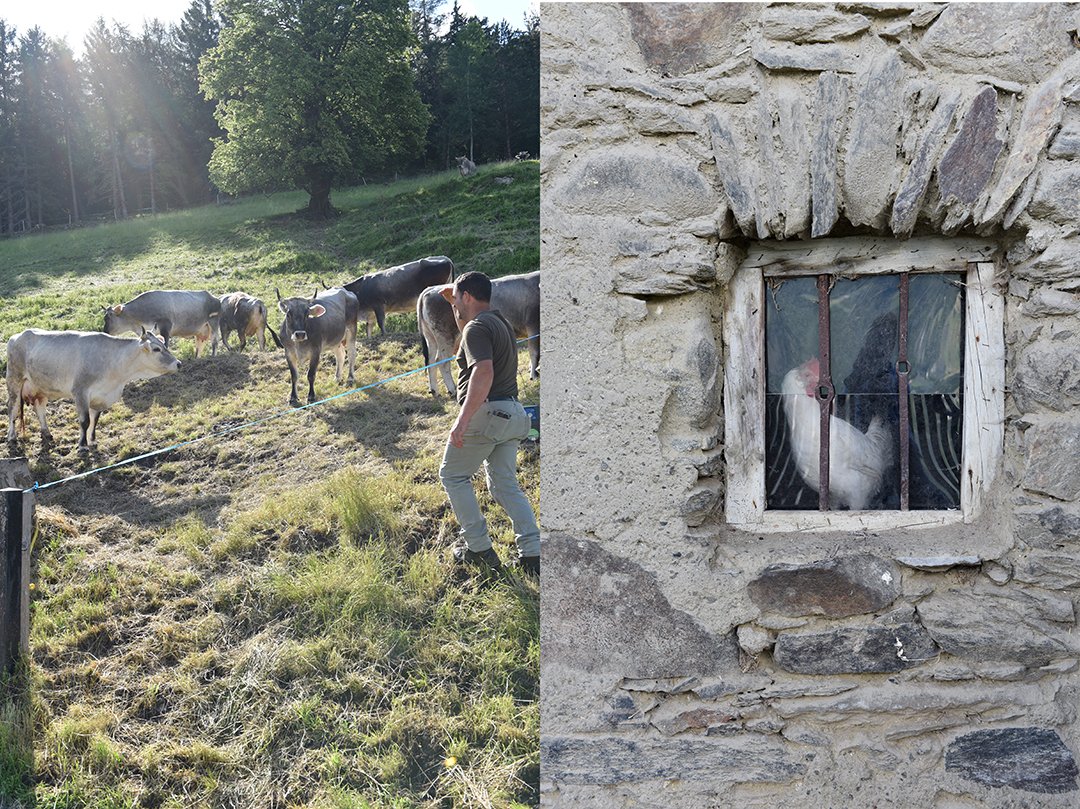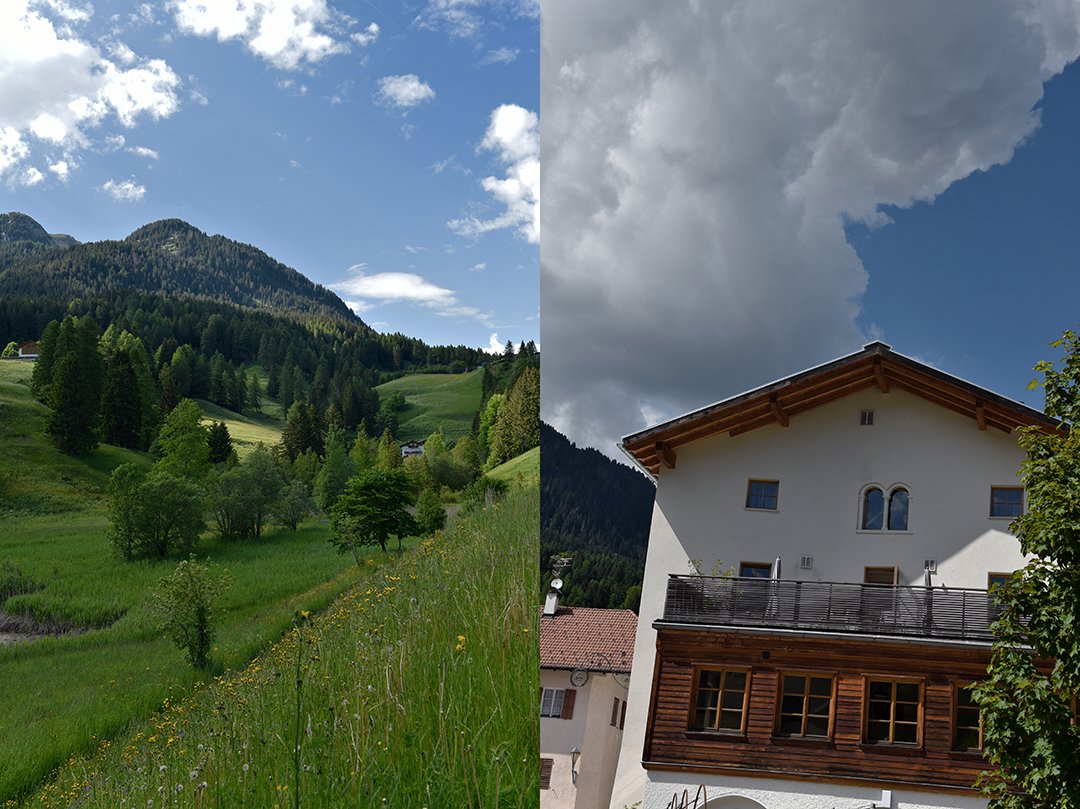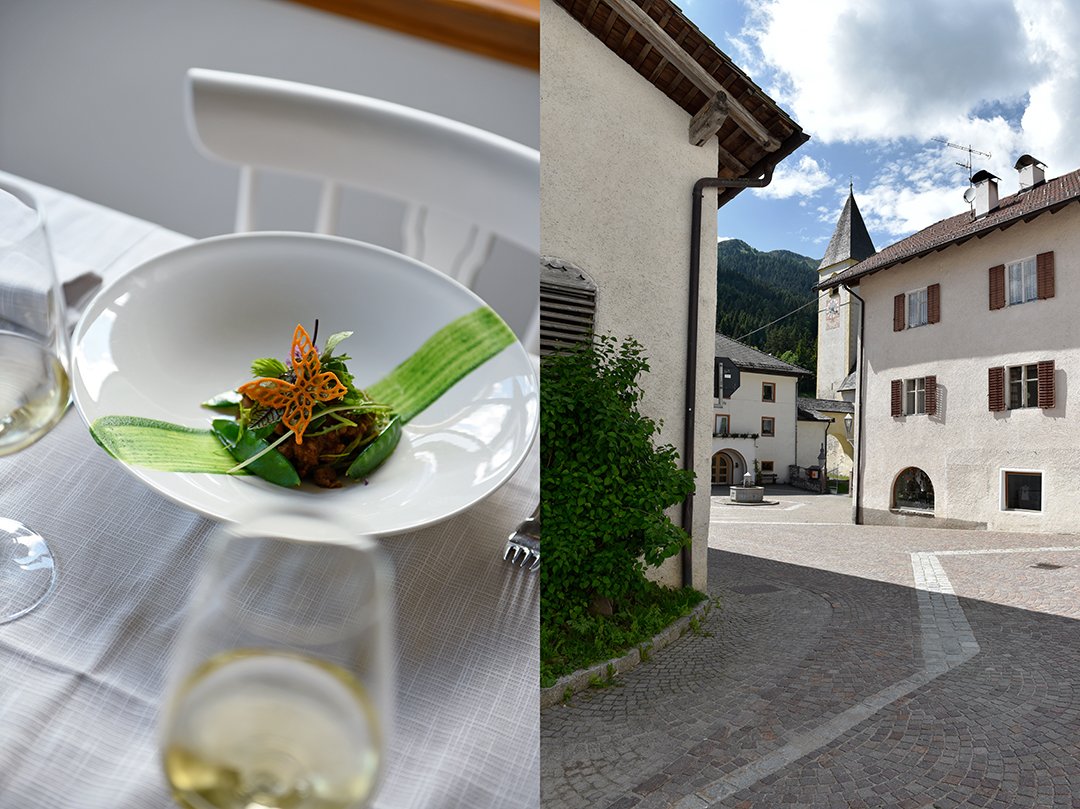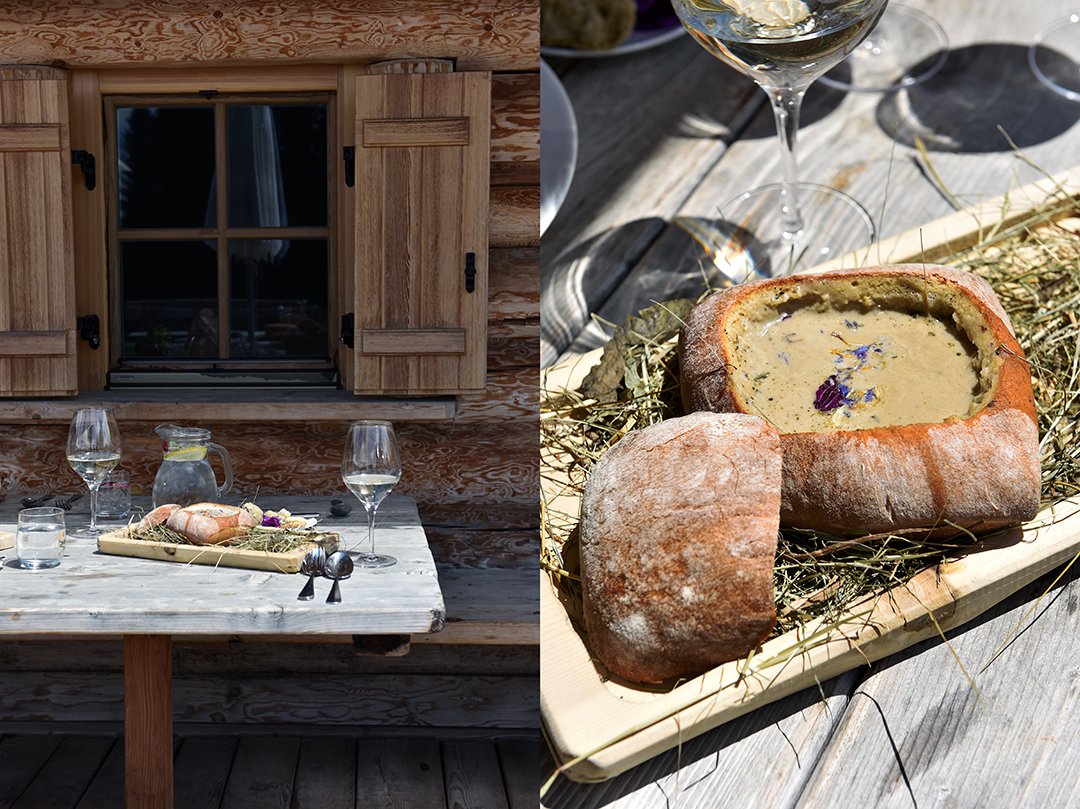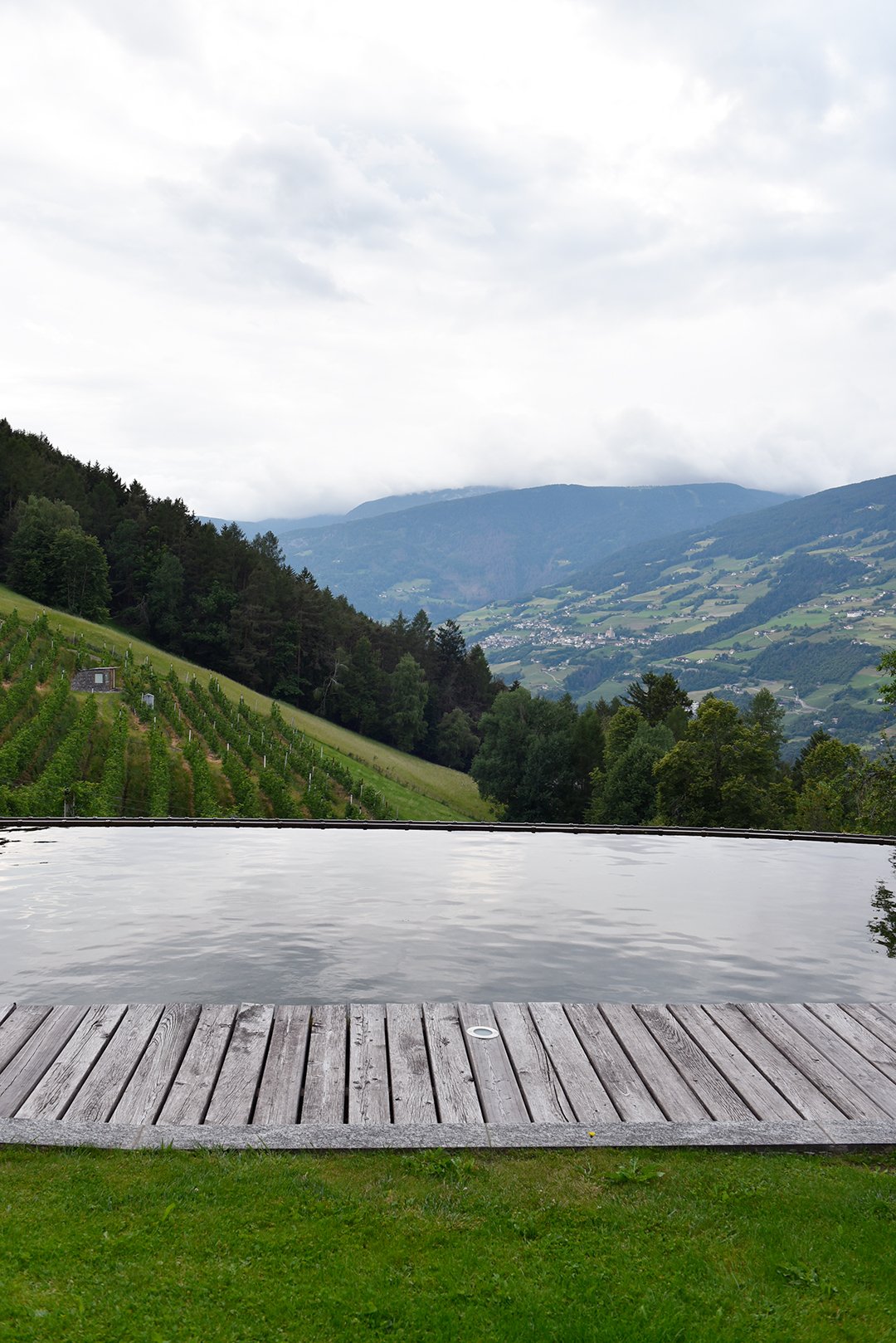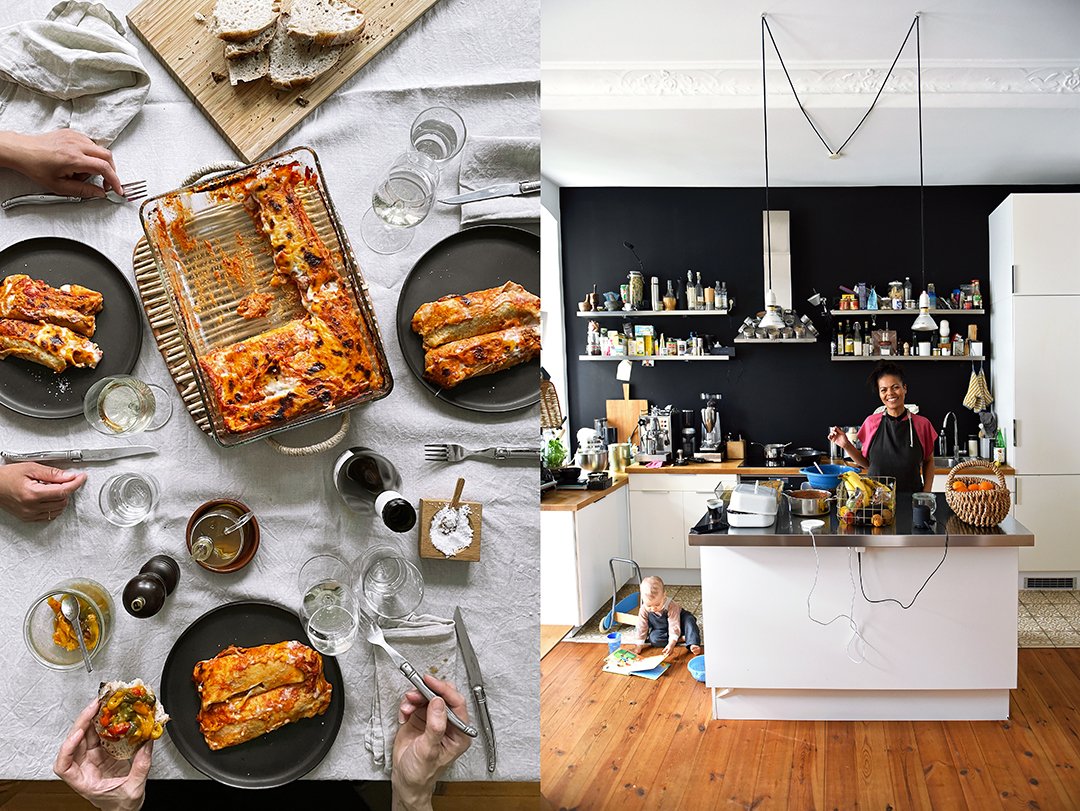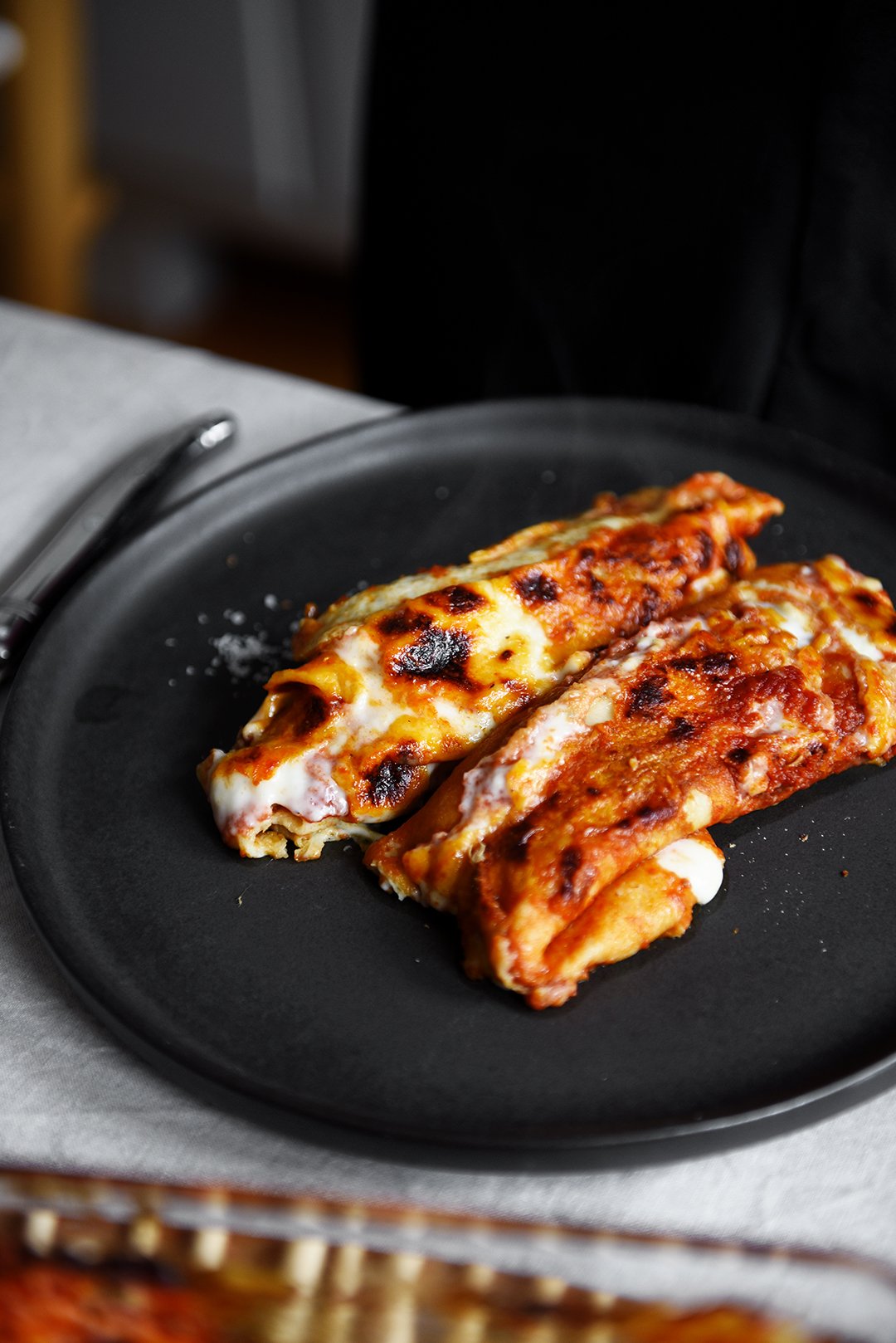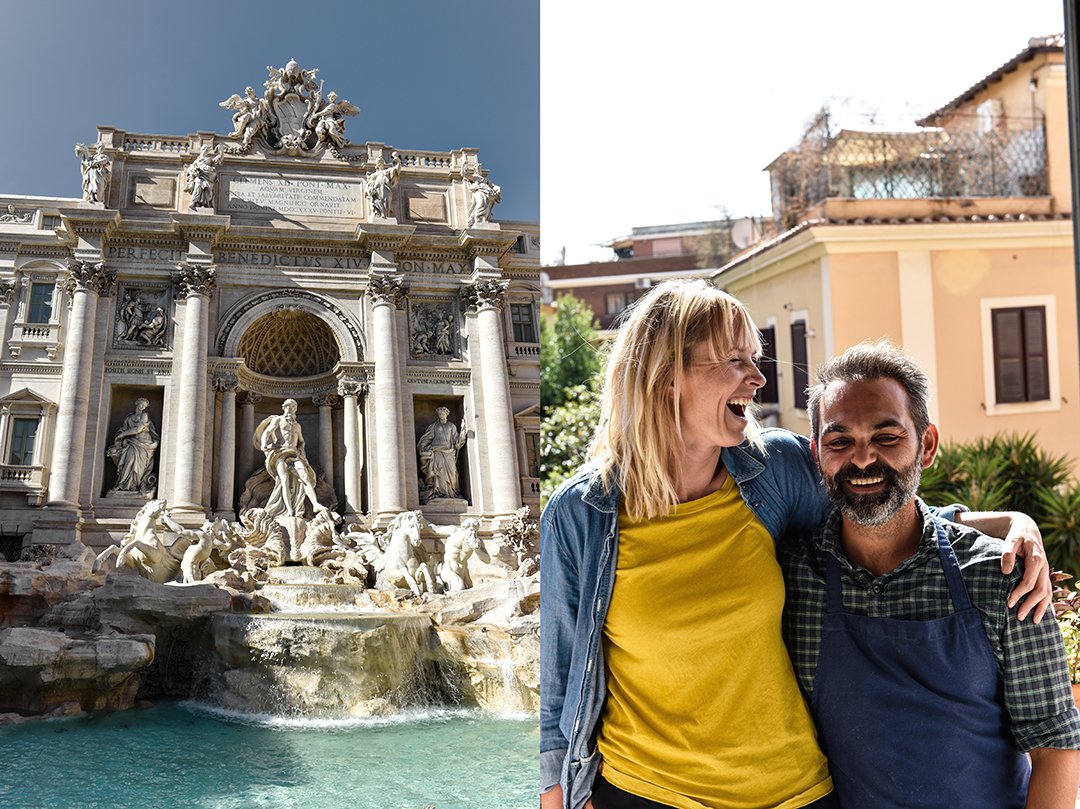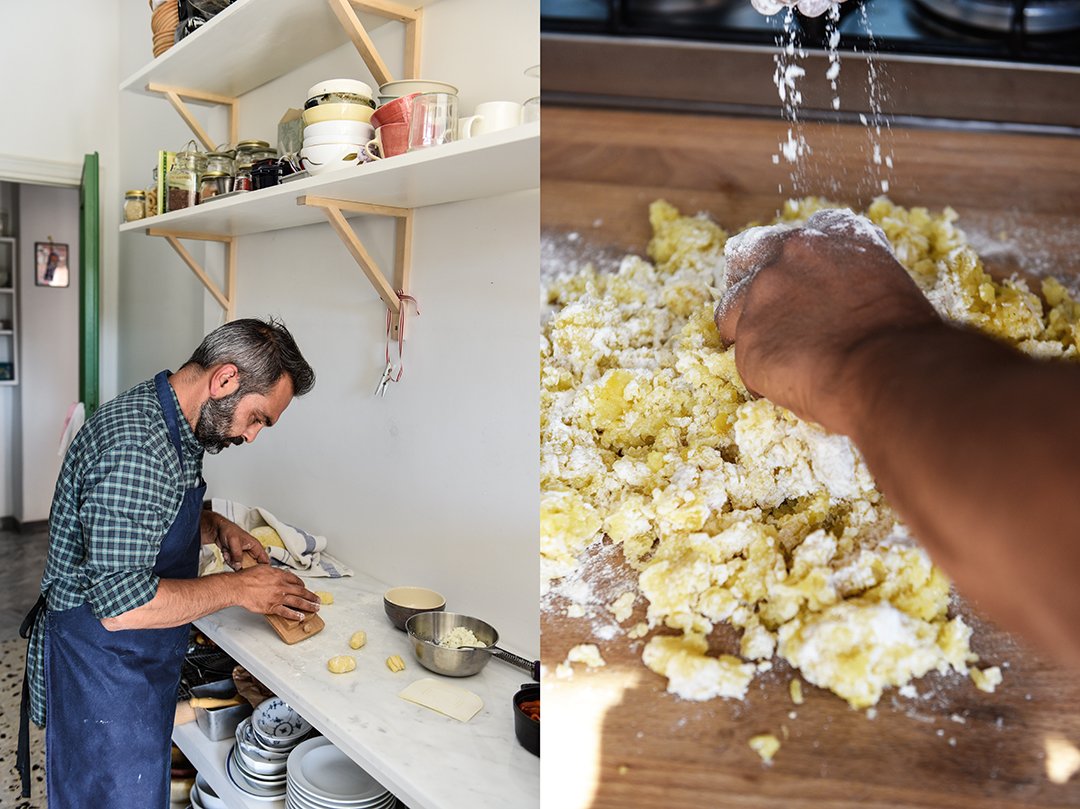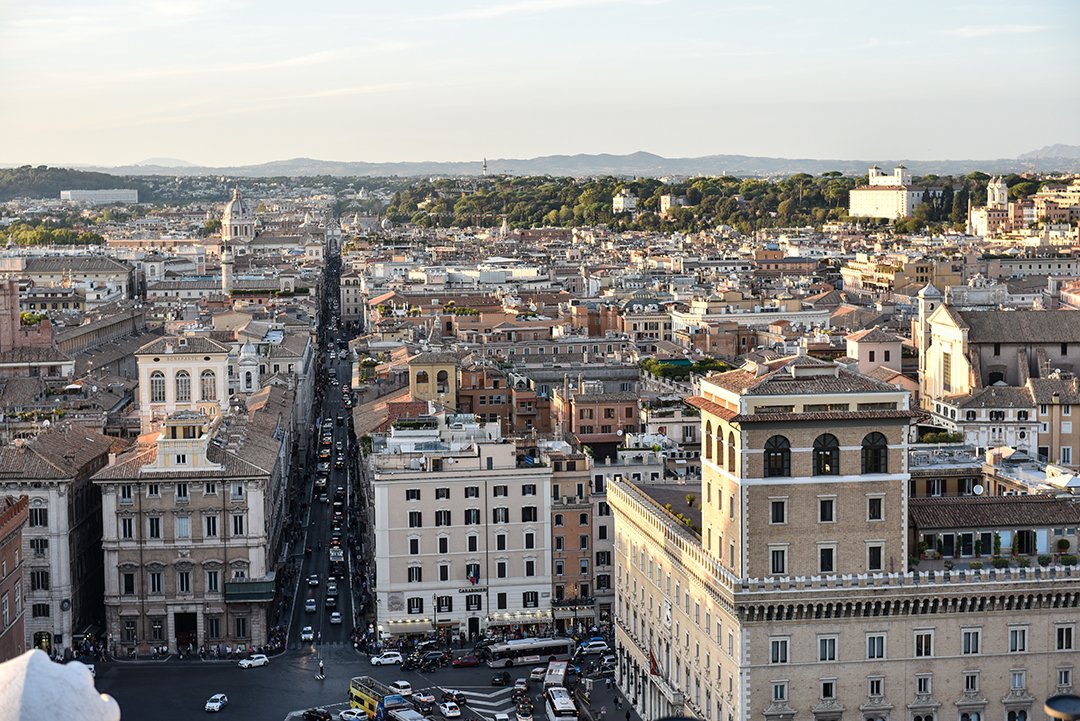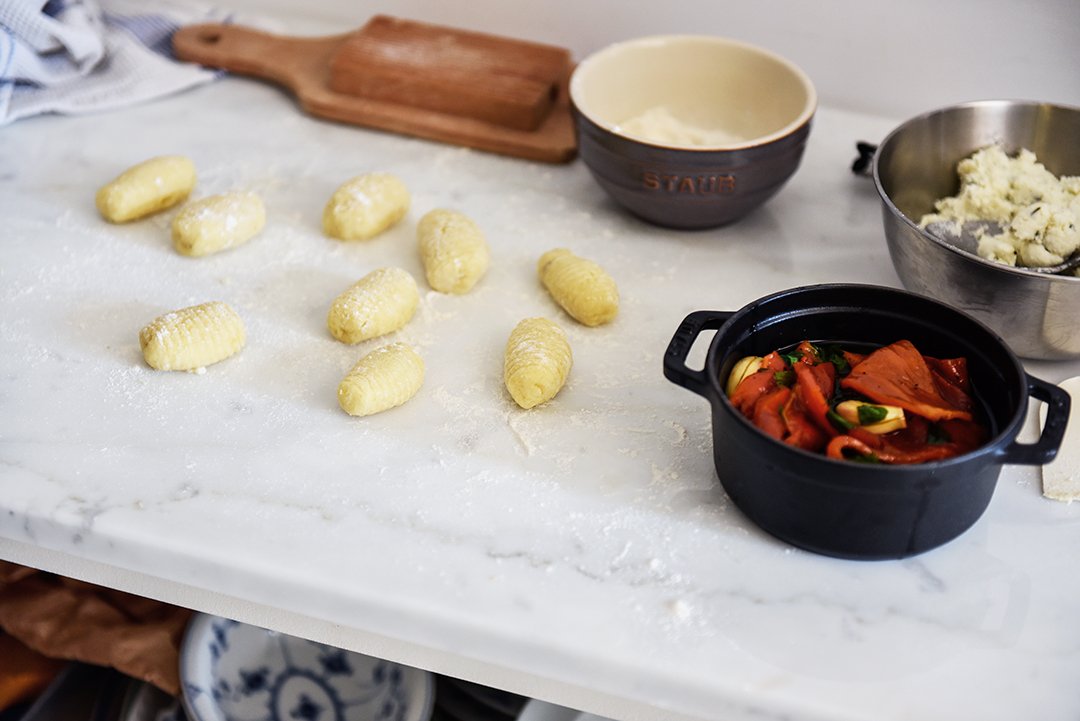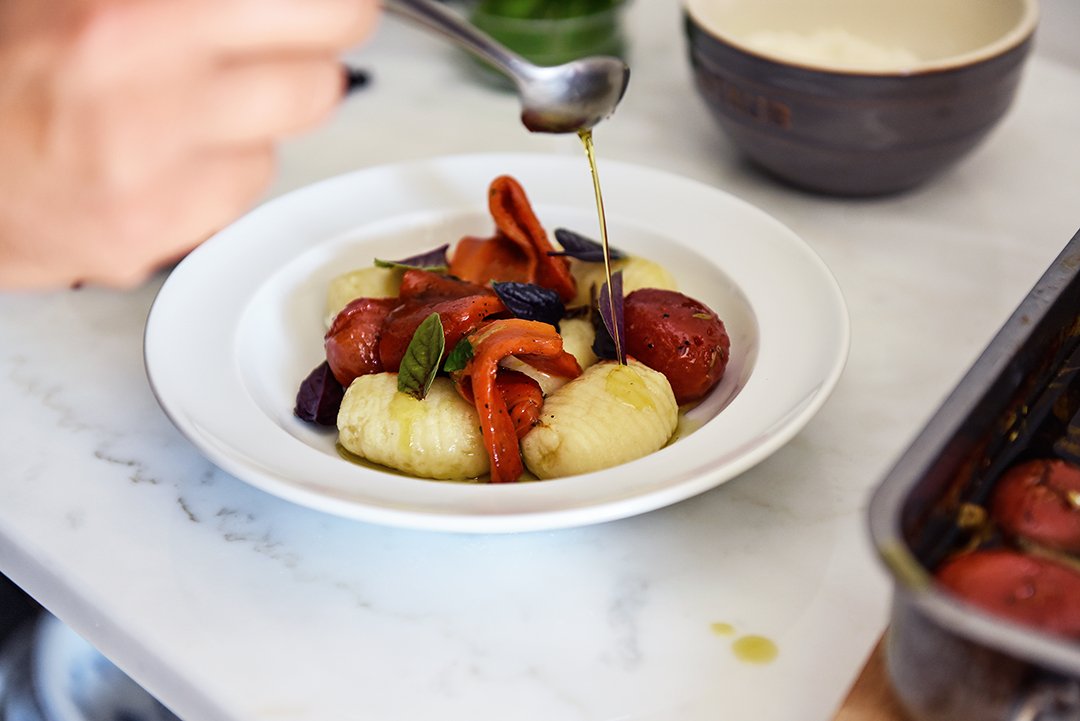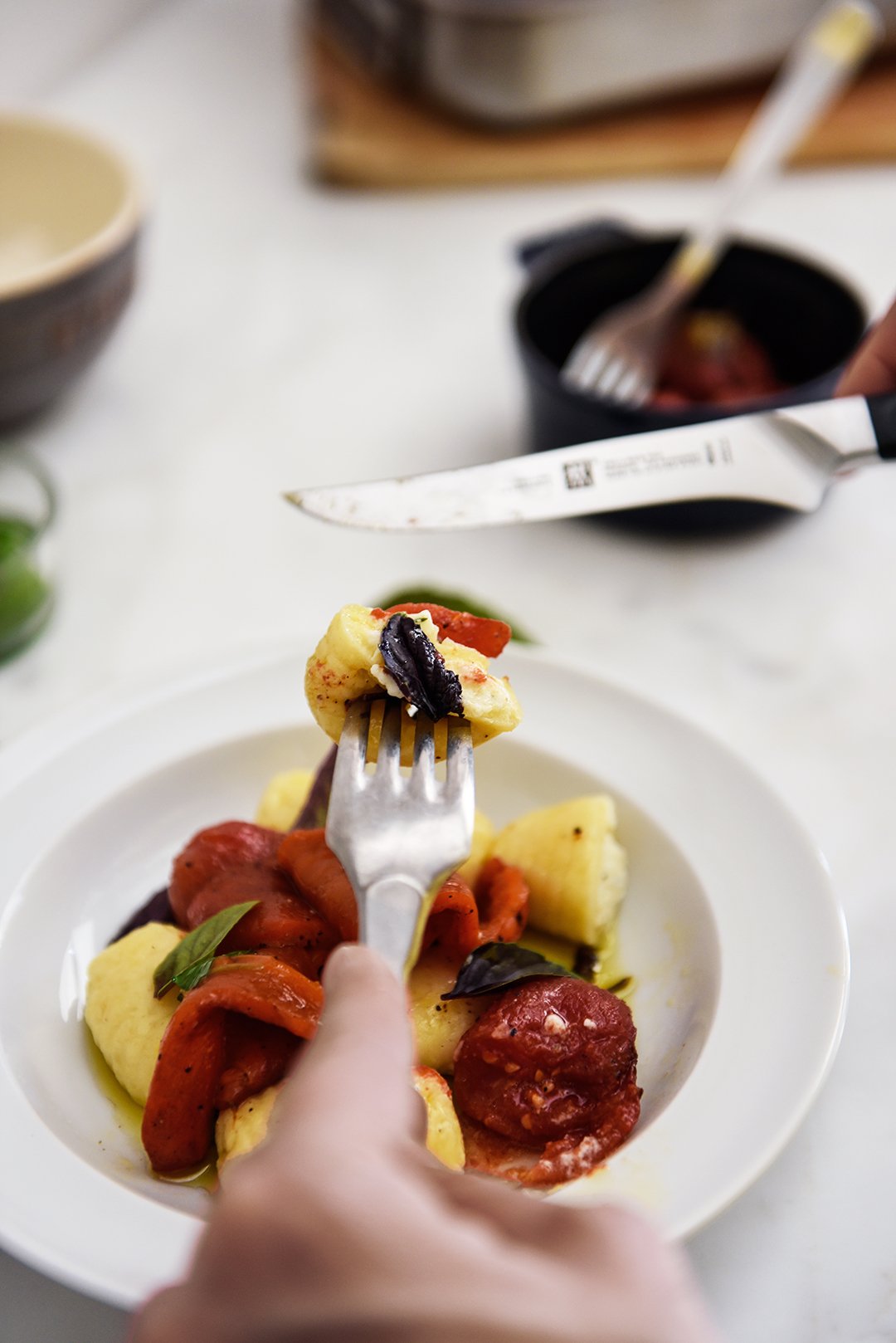Knoedel, Mountains and a Road Trip in South Tyrol
I went to South Tyrol for a little road trip, to sip on crisp mountain air and get lost in lush landscapes. The region’s faces change as quick as the weather, from serene soft hills to secluded villages and rugged mountain ranges. To me, no mountains are as majestic, as imposing as Northern Italy’s Dolomites. Their raw beauty makes you speechless. The French architect Le Corbusier called them “the most beautiful architectural artwork in the world.”
My expectations were high when I hopped off the plane and into my rental car. I know this region since my childhood days, this is where I used to spend my skiing holidays since I was nine years old, thanks to my stepfather who introduced my family to the picturesque village of Corvara. The food of the Dolomites, its monumental rock formations, the rustic architecture in the tiny mountain villages, all this left a deep love for this region and many marvelous memories inside me.
Although Corvara wasn’t marked on my travel map this time, I discovered new places, met so many inspiring people, and created new memories. My road trip started in Bolzano, South Tyrol’s capital, and I stayed at the newly renovated and utterly gorgeous Parkhotel Mondschein. The charming terracotta-colored Art Nouveau facade doesn’t show that the building’s oldest part dates back to 1320. The hotel is right in the medieval city center, set in a peaceful park with an almost Mediterranean vibe. The green oasis, dotted with palm trees, pretty umbrellas, and comfy sun loungers, was my first stop - for a welcome aperitivo - and my last one - for a luxurious breakfast. I could have stayed forever, chilling on the lounger, staring into the dramatic sky, and sipping on my elderflower cocktail.
So I was almost late for dinner, but Norbert Kier and his Enoteca Italia & Amore soon made me forget about my comfy lounger. It was just a short walk from my hotel, but it gave me the chance to enjoy the beauty of Bolzano’s historic center; chunky cobblestones and ice cream-colored buildings, and thunderstorm clouds that seemed ready to burst anytime - they didn’t, thankfully.
I set outside on the restaurant’s terrace, starting off with Battuta di Fassona (a beef tartare from the Fassona Piedmontese breed, which comes from Slow Food-certified Fassona cow farms), sandwiched with stracciatella di bufala, mustard, and pistachios. As I couldn’t decide which starter I should go for, Norbert also served me a Carpaccio di Fassona topped with summer truffle. Paccheri Pasta with Fish Ragù was placed in front of me next, simply divine, and so was the Quail with Swiss Chard and Lemon. I finished my lavish first dinner with Panna Cotta with Aniseed and Candied Cherries, which was so good and - as Norbert told me - it was made without gelatin, just with very rich, fatty heavy cream.
The restaurateur used to visit all Michelin 3-star restaurants around the globe every year. Norbert was always hungry for the new, for the next big thing, for the exciting. Now, he says, he’s not going anywhere anymore, now, he stays in Bolzano where he and his chef, Giuseppe Avitabile from the Amalfi Coast, want to show their guests what you can do with the region’s outstanding local produce. I’m hooked, I’ll come back.
My road trip began the next morning and reminded me that South Tyrol is so much more than breathtaking landscapes and an extraordinary cuisine. South Tyrol teaches you to listen to the silence, to breathe in, and just enjoy what nature reveals in front of you. And if you also listen to the people, to the Südtiroler (South Tyroleans), you can learn a lot about family and community, about bonds grown and tightened over generations; about traditions being lived, questioned, and sometimes readjusted.
In South Tyrol, you don’t just create for yourself, you create to preserve, or rather, you create to pass something on to the next generation. And maybe here lies the origin of the South Tyroleans’ focus on quality: they want to pass something on that has a value for the next generation. Maybe it’s pride, but also a sense of responsibility.
Right after breakfast, I left Bolzano to drive deeper into the mountains, to a farm in Partschins, close to Merano. The roots of the Oberbrunnhof date back to the 14th century. The rural farm has already been in the hands of farmer Manuel Laimer’s family for five generations. In 2004, Manuel’s grandmother passed Oberbrunnhof, its land and its traditions, on to her grandson and his wife, Caroline. Since then, the farm kept flourishing in the couple’s hands, and the family kept growing - three children guarantee that, potentially, the foundation for the next generation of farmers has been laid.
Both Caroline and Manuel stay very close to the traditions of this place; not because they have to, they do it out of free will and very passionately. Following the farm’s long breeding tradition, a herd of Tiroler Grauvieh (Tyrolean Grey), a typical Alpine cattle breed, enjoys the panoramic view from their meadows, while chickens run around them in respectful distance. Caroline affirmed that the Grauvieh is peaceful, as long as you follow farm rule no. 1: never approach a cow from its back, always from the front. The cattle is the farm’s pride, but the farm’s restaurant is what pulled me towards Oberbrunnhof.
Caroline is a home cook turned chef, she also serves and entertains her guests, treating them with traditional South Tyrolean dishes, such as Cheese Knoedel with Krautsalat (you can find her recipe at the end of this post), Brotsuppe (bread soup), Saures Rindfleisch (sour braised beef), speck and sausages from the farm, and her famous Apfelstrudel (apple strudel). The traditional spiced bread served along the dishes is baked by Manuel in a tiny room with an old wood-fired oven. The wall on one side of the room is covered with rustic wooden shelves where 200 fluffy pieces of dough, shaped into small ovals, sit and rise slowly. Once a week, Manuel starts the fire at 5am so that he can bake the little loaves at around noon.
The couple works constantly, from morning until night, there’s no holiday and no day off, but they don’t seem stressed. Life on the farm follows the family’s pace, not the other way around. It’s a lot of work, also hard physical work, but Caroline, Manuel, and their three children managed to create a very satisfying life for themselves. They don’t romanticize it, they just found their place.
You can visit the farm’s restaurant by reservation, but you can also stay for longer in their holiday cottage, Chalet Waldbrunn.
The hard part of being on a road trip is that, once you got comfortable at one place, you have to move on again. The great part of being on a road trip is that new adventures, more beauty, and more fantastic food are waiting for you at your next destination. So I hopped in my car, turned on the radio to listen to Italian pop music, and enjoyed the stunning scenery on my way to a tiny village with the poetic name Unsere Liebe Frau im Walde (Our Dear Lady in the Forest).
Unsere Liebe Frau im Walde is South Tyrol’s oldest pilgrimage site. Various legends circle around a Marian apparition in the 12th century, attracting pilgrims from near and afar since then. A Hospitium for the pilgrims was set up by monks and, with rising popularity, a Baroque church was built next to it in the 14th century. The guesthouse still exists and became a hotel at one point. The name couldn’t be more typical for SouthTyrol, it’s called Zum Hirschen (Hirsch means deer in German), yet the hidden retreat is anything but an ordinary hotel.
Run by a very charming mother-daughter-son trio, it’s a place where history is being respected, but interwoven with the needs and longings of modern travelers, searching for peace and tranquility - and for excellent food. The green hills and woods surrounding the Hirsch raise Wanderlust, two mountain lakes, Lago del Monte Luco and Lago di Tret, call for a bike ride and a refreshing swim.
Mamma and patroness Edith Kofler is the hotel’s guardian angel, guide-running the hotel with patience and a smile on her face, and with utmost trust in her children’s decisions. Ingrid and Mirko Mocatti, now the 3rd generation of hoteliers in the family, are two siblings who respectfully divide their responsibilities, but also ask each other for advice.
Ingrid is responsible for the hotel restaurant’s refined yet comforting cuisine, rooted in South Tyrol and the neighboring Trentino region. At Cervo, local ingredients and a deep knowledge of wild herbs are at the core of the menues that follow the rhythm of the seasons. In many of the young chef’s dishes, you can find traces of Hildegard von Bingen’s herbology. The famous German Benedictine abbess, an emancipated polymath, composer, philosopher, medical writer and practitioner, lived in the High Middle Ages and studied and cultivated a holistic approach to well-being.
Working with the past, but also with her own curiosity and her strong belief in the Slow-Food movement, Ingrid creates drinks and dishes that nourish the body and the soul. Her fir needle lemonade, served at my arrival, felt like a hug; her stunning Onsen Egg with Herb Salad and Potatoes was a traditional yet at the same time modern culinary interpretation of a walk through the woods (and yes, you can eat baby fir cones).
Nature’s generous in South Tyrol, you just have to keep your eyes open. And that’s what Ingrid does. Nettles are turned into tagliolini with deer ragù, a fir needle-herb oil refines the creamy Bergwiesenschaumsuppe (mountain meadow soup) with smoked mountain char, meat and grains come from local producers, traditional farmers and mills. And the dessert of Topfenknoedel (ricotta dumpling), to finish off my divine dinner, made my heart jump.
With virtuosity and a clear, calm vision, Ingrid manages to incorporate the values of this historic place in her cooking. Her brother, Mirko, manages to translate these same values - in a very pure and simple form - into the hotel’s honest philosophy; he lets the values manifest themselves in modern design and architecture that respect the past, but aren’t put in chains by it. Every detail, every material, every piece of furniture is chosen responsibly and sensitively; every decision, every change is made with imperturbable trust, respect, and confidence.
The people who are shaping Zum Hirschen bring in so much of themselves, of their own character, so much love, passion, and devotion, that by doing so, they give this place a soul. It truly is a place that calms you down, there’s an ease that you can feel here; through nature’s beauty, through the clarity and serenity of the rooms, and through the food that tastes so good and makes you feel so good. In that respect, Zum Hirschen is still a Hospitium, staying true “to the ancient Greco-Roman concept of hospitality as a divine right of the guest and a divine duty of the host.”
Although Papà Giorgio stays more in the background, his wise words don’t:
“Inspiration is essential for every creative soul. Just like the sun, that’s breaking through the forest’s darkness, brings light, so does inspiration bring light to life. Here, in the secluded Val di Non Valley, I find strength and inspiration, time and again.”
The Dolomites are majestic, they seem out of reach, but you can get close to them, even without having to climb. The Seiser Alm is the perfect choice if you want to feel like an alpinist for a day - but without up-sailing. I wore my sneakers and a sunhat and was ready for a relaxed summery hike, past the imposing landmark Schlern (2.564 m / 8,412 ft) that looks like the bow of a ship, and towards the mountain range Marmolata - the “Queen of the Dolomites” (3.343 m / 10,968 ft). Their peaks seem to cut right through the clouds.
My desire to climb the queen was limited, my appetite for lunch was stronger. The open plateau of Seiser Alm is the largest high-altitude Alpine meadow in Europe, a blooming attraction in summer, turning into a winter wonderland as soon as the first snowflakes start to fall. On the culinary side, the mountain pasture offers romantic mountain hut vibes to dive into rustic mountain cuisine.
I visited Franz Mulser’s Gostner Schwaige, a 350-year old Berghütte (mountain hut) that couldn’t be any prettier in a fairytale. I was prepared for a frugal merende (lunch snack) of speck, cheese, and Schüttelbrot (crunchy spiced mountain flatbread) but the farmer, cheese maker, chef, and proprietor of the picturesque hut - he owns it since he was 21 years old and left his carrier in Michelin-starred restaurants behind - had different plans. I was presented a South Tyrolean feast!
Franz extended the humble merende into a lavish lunch of a spectacular Heusuppe (hay soup, which is really made of hay and flowers and also tastes like it) and Schlutzkrapfen (Tyrolean dumplings made with carob flour and filled with Alpine cheese fondue). The Kaiserschmarrn that followed was the best I’ve ever had (there’s a recipe for this torn pancake on the blog, click here).
Making cheese has long been a tradition in Franz’s family and also at Gostner Schwaige. Since its early days, the hut had been used for making cheese, and the recipe for Franz’s Tiroler Graukäse (grey cheese, rennet-free and very low in fat) dates back to these days. Whenever the temperatures are warm enough, the cattle grazes on the Alm’s meadows. However, cows are temperature-sensitive. When it’s too cold, they get stressed - I feel with them - releasing stress hormones, which would also harm the final cheese.
Franz strongly believes in the quality of the raw product, in the milk. He knows that only good milk can make good cheese. So it’s his job to make sure that his cattle stays happy and the milk quality stays constant. And then, according to the seasons, the flavor of the grass changes, the flavor of the milk changes, and so do the flavors and textures of the cheeses that he produces change. For him, tradition means to preserve the old, by using new knowledge and experiences, to gently guide tradition into the future. In his case, that’s a very tasty endeavor.
My trip came to an end, not a sad end, but one that left me filled with new memories and lots of inspiration. Before I checked in my last hotel, I visited the natural wine makers Carmen and Hannes Röck at their winery, Weingut Röck, for a spontaneous wine tasting. The siblings took over production from their father a few years ago, shifting from conventional to low-intervention wine making. They still work within their family tradition, but just like the other chefs, farmers, cheese makers, and hoteliers who I met, they had the freedom to find their own path. Their wines are outstanding and they taste the way they taste because Carmen and Hannes create and shape them. Passing on an established business from one generation to the next is never easy. It’s a story of letting go, of fears, of being brave and reckless sometimes, but first and foremost, it’s a story about trust.
The stunning Ansitz Fonteklaus, solid like a rock since 1706 and first mentioned in 1317, looks like a fortress and makes you feel like you found the safest place on earth. The hotel offers marvelous views, the prettiest rooms, and a gorgeous (and crystal clear) infinity swimming pond - which I had to share with two tiny frogs, but they didn’t seem to mind my presence. There were even more traditional South Tyrolean treats on the table for my last dinner at the hotel’s restaurant, cooked by chef Andreas. I happily indulged in them, and in the starry sky, before I slept as peaceful as a baby.
Thank you, Caroline, Manuel, Edith, Ingrid, Mirko, Giorgio, Franz, Norbert, Giuseppe, Carmen, Hannes, Erich, everyone at Parkhotel Mondschein, Zum Hirschen, and at Anistz Fonteklaus - all of you made this magical trip happen!
This post has been sponsored by Visit South Tyrol. The people and places featured in this post were chosen by me, the opinions are my own. Thank you, Dagmar, for helping me put this unforgettable road trip together!
Caroline’s South Tyrolean Cheese Knoedel with Krautsalat
by Caroline Laimer
For the knoedel
You can prepare the knoedel mixture a day in advance and keep it in the fridge. You can also shape the knoedel and freeze them, either cooked or uncooked (and cook them after defrosting them).
Makes 20 knoedel
80g / 3 ounces unsalted butter
70g / 2 1/2 ounces onions, finely diced
500g / 17 1/2 ounces stale white bread (about 1-2 days old, hard rind removed), cut into small cubes
400g / 14 ounces mixed aromatic hard cheese, grated (you can also add a little gorgonzola)
300 ml / 1 1/4 cups whole milk
20g fresh parsley leaves, chopped
sea salt
ground pepper
6 large eggs
dried breadcrumbs, for sprinkling the baking sheet
In a large pan, heat the butter over medium heat and cook the onions, stirring occasionally, for about 15 minutes or until golden and soft; transfer the onions to a medium bowl and let cool for 5 minutes.
In a large bowl, mix together the bread, cheese, onions, milk, and parsley, then season to taste with salt and pepper, add the eggs, and mix with your hands until very well combined.
Line a baking sheet with parchment paper and sprinkle with dried breadcrumbs.
Wet your hands and shape the knoedel mixture into 20 large round knoedel, rolling them between your hands and gently pressing the mixture together, then transfer the knoedel to the prepared baking sheet.
In 2 large pots, bring salted water to a boil then add the knoedel, reduce the heat to a gentle boil, and cook for about 10 minutes, or until the knoedel are firm and cooked through. Using a slotted ladle, transfer the knoedel to a sieve and drain for a minute.
For the krautsalat
Serves 2
1 large handful very thinly sliced or shredded green cabbage
caraway seeds
sea salt
sunflower oil or rapeseed oil (mild flavor)
white wine vinegar
ground pepper
In a medium bowl, sprinkle the cabbage with 1/4 teaspoon of caraway seeds and 1/4 teaspoon of salt then mix well with your hands and let sit for 10 minutes. Season to taste with oil, vinegar, caraway seeds, salt, and pepper.
Spread some krautsalat on a plate, arrange 1-2 knoedel on top, and enjoy while the knoedel are warm.
Meet In Your Kitchen | Maria's Cannelloni al Ragù
This post is part of my Meet in My Kitchen podcast: How did we get to where we are in life & what does food have to do with it
“I think it’s amazing that we need to eat to survive but the way to survive is to do something that is amazing to do, that you can enjoy, that you have the privilege, the luxury, three, four times a day to do something out of necessity that you can enjoy as one of the I would say best things there is in life.” - Maria Gerace
The first time I met Maria Gerace she came to a Saturday lunch at my apartment, we started at noon and parted at 4 in the morning. Mussels, crêpes, late night pasta, and many bottles of vino - that was the perfect start of a friendship that would always circle around food, wine, and long conversations. When I go to Maria's kitchen she makes cannelloni for me - not a couple but 20 (you can find the recipe below, Maria uses crespelle/ crêpes for the cannelloni instead of cannelloni pasta). In her kitchen, she's my Italian mamma who always takes care that my plate (and glass) is never empty!
Maria grew up in a small town in Calabria, close to the sea, right at the tip of Italy's boot and far away from the life she was longing for. She was raised by her grandmother who planted the seed in the young girl's soul that a good life is always connected to good food and to people to share it with.
At a young age Maria was already used to patiently peeling pounds of fava beans in the evening in front of the TV; to making passata in the garage once a year with the entire family, each member having at strict role in the procedure - a hierarchy that only slowly alters with age. Food was never just prepared for oneself, but always shared with the whole family. The famous Sunday tomato sauce enriched with polpettine, a weekly ritual, which smell and taste is so deeply woven into her memory, was a frugal feast in her granny's kitchen that no family member dared to miss. The young ones brought their boyfriends and girlfriends, the aunts and uncles sharing laughs and stories, a constant flow of people pulled to the kitchen of a woman who held everything and everybody together like a magnet.
Once a year the family would gather and go on a 'pilgrimage' to slaughter a pig at a small village close by. The blood would be collected immediately to make sanguinaccio, cooked with cocoa, sugar, and spices it was turned into a rich chocolate sauce that the kids loved. Even for the young ones it was normal that every part of an animal was used, that the whole family would always be involved in every food endeavor, and that there were recurring culinary rituals that marked the flow of the year and made it special. Traditions that everyone was longing for.
Although her curiosity and hunger for life made her leave the south of Italy to study industrial design in Milan, to travel and experience the world and widen her view, to then settle in Berlin with her husband Jan and work as an eyewear designer, Maria's voice always mellows when she talks about her granny, about Italian food, and the sea.
The podcast episode with Maria Gerace is in English. You can listen to the Meet in My Kitchen podcast on all common podcast platforms; there are English and German episodes. You can find all the blog posts about these podcast episodes including my guests' recipes here on the blog under Meet in Your Kitchen.
Listen to the podcast episode with Maria on:
Spotify / Apple / Deezer / Google / Amazon / Podimo
On Instagram you can follow the podcast @meetinmykitchenpodcast!
Cannelloni al Ragù
by Maria Gerace
There are many steps involved in the preparation of this dish, so it makes sense to cook it in larger quantities.Cannelloni freeze very well. Follow this recipe and freeze them (in the baking dish) before (!) baking the crespelle in the oven. After defrosting them you can bake them following this recipe again. You can also prepare the ragù and the tomato sauce a day ahead.The crêpes and béchamel sauce (in case you don't use store bought sauce) should be made the day you finish the preparation and then either bake or freeze the cannelloni.
Makes about 20 crespelle / Serves 7-10
For the ragù (you can prepare the ragù a day ahead)
100 ml / 1/3 cup plus 2 tablespoons dry white wine
Extra virgin olive oil
1 medium onion, peeled and finely diced
1 medium carrot, peeled and finely diced
1 stalk of celery, peeled and finely diced
1 clove garlic, peeled and finely chopped
500g / 17 2/3 ounces ground beef (or mixed beef/ pork)
1kg / 2 1/4 pounds canned whole peeled tomatoes, crushed (or canned crushed tomatoes)
Fine sea salt
Freshly ground pepper
Nutmeg, preferably freshly grated
For the crêpes
600ml / 2 1/2 cups whole milk
1 tablespoon extra virgin olive oil
3 large eggs
225g / 1 3/4 cups all-purpose flour
Nutmeg, preferably freshly grated
Fine sea salt
Unsalted butter, to cook the crêpes
For the tomato sauce (you can prepare the tomato sauce a day ahead)
Extra-virgin olive oil to taste
1 clove garlic
500g / 17 1/2 ounces tomato passata
Fine sea salt
To finish the cannelloni
1 liter / 4 1/4 cups thick béchamel sauce*
Parmesan, freshly grated
Nutmeg, preferably freshly grated
500g / 17 2/3 ounces Provola cheese, cut into cubes
* Here is my recipe for béchamel saucefrom my book '365'
1 liter / 4 1/4 cups whole milk
1 large bay leaf
Nutmeg, preferably freshly grated
Fine sea salt
Finely ground pepper
45g / 3 tablespoons unsalted butter
45g / 1/3 cup all-purpose flour
For the ragù, simmer the white wine in a medium saucepan for 5 minutes to boil off the alcohol and reduce acidity. In a large pan, heat a splash of olive oil over medium-high heat, add the onion, carrot, celery, and garlic, and sauté, stirring occasionally, for about 4 minutes. Add the ground beef and a little olive oil and cook over high heat, stirring to break up the meat, for a few minutes or until the meat is browned. Add the wine and deglaze the pan, using a spatula to scrape any bits and pieces off the bottom, then add the tomatoes. Season to taste with salt, pepper, and nutmeg and gently simmer over medium-low heat for 1-2 hours; the ragù should be thick. Place a large colander in a deep sheet pan then pour the ragù into the colander to drain any excess liquid; for the filling, the ragù needs to be very thick and not runny. Set the sauce collected in the sheet pan aside. Let the ragù cool completely.
For the crêpes, whisk together the milk, olive oil, and eggs then add the flour and a pinch of nutmeg and salt and whisk, using a stand mixer or a whisk, until smooth and well combined. Let the batter sit for about 30 minutes.
For the tomato sauce, heat a splash of olive oil in a large pan over medium heat. Add the garlic and sauté for a few minutes then add the passata, season with a pinch of salt,and cook for 10 minutes. Remove the garlic then let the sauce cool for at least 15 minutes.
For the béchamel sauce, combine the milk, bay leaf, 1/4 teaspoon of ground or freshly grated nutmeg, 1/4 teaspoon of salt, and a pinch of pepper in a medium saucepan and bring to a boil. Immediately take the pan off the heat, remove and discard the bay leaf, and set aside. To make the roux for the béchamel, melt the butter in a separate medium saucepan over medium-high heat and as soon as it’s sizzling hot, whisk in the flour. Slowly pour the hot milk mixture into the roux and whisk until smooth. Simmer on low, whisking occasionally, for about 5 minutes or until the sauce starts to thicken. Season to taste with nutmeg, salt, and pepper and set aside.
To cook the crêpes, spread out 4-6 kitchen towels on a work surface. In a 20 cm / 8“-non-stick pan or cast iron skillet heat 1/2 teaspoon of butter over medium-high heat. Pour in a ladle of the batter, tilting and turning the pan so that the batter spreads evenly and very thinly. Cook the crêpe, flipping once, for about 30-60 seconds per side or until golden. Spread the crêpe on the prepared kitchen towels and continue cooking about 19 more crêpes with the remaining batter, adding a little butter to the pan and adjusting the heat as necessary.
Preheat the oven to 180°C / 350°F.
To finish the cannelloni, spread a little tomato sauce on the bottom of 2 large baking dishes, drizzle with a little béchamel sauce, and sprinkle with a little Parmesan. Season each crêpe with a little nutmeg and sprinkle with a little Parmesan. Place a generous spoonful of the ragù in the middle of each crêpe and top with Provola and a spoonful of béchamel sauce. Gently roll each crêpe into a tight wrap and arrange them tightly, side by side, in the prepared baking dishes. Cover the crêpes with the remaining tomato sauce, the sauce collected from the ragù, and the béchamel sauce, sprinkle with a little Parmesan, and bake for 30-40 minutes or until it’s bubbling and the top is golden brown. Let the crespelle sit for a few minutes before serving.
Meet In Your Kitchen | Love, Rome & Gnocchi
Imagine your friends throw an opulent dinner party in the pulsing heart of Rome on a Saturday night und you take over their kitchen hours before the guests arrive with a film team of four to peek over your hosts' shoulders into their pots and pans. Sofie Wochner and Domenico Cortese dealt with our little invasion with remarkable patience. They even welcomed us with big smiles on their faces and a plate full of fresh buttery Danish cinnamon buns in their hands.
The passionate couple is a confident team in the kitchen, they complement each other and combine two worlds that are geographically and culturally far apart, but somehow match smoothly. Sofie is a Danish baker and pastry chef with the impulsive temper of an Italian Signorina, self-taught Chef Domenico comes from Calabria, from the southern tip of Italy, but totally lacks the Mediterranean drama that one would expect. His voice is calm and his movements are concentrated, he's quiet and focused when he works in the kitchen. He says he was born in the wrong country, he feels much closer to the northern European mentality, whereas his woman only feels as free and inspired as she wants to be when she's in her adopted city, in Rome.
A city kitchen is often a space of improvisation and elaborate compromises, the smallest but also the most charming room of an apartment. It's the place where everybody meets at a party, making use of every square inch, squeezed and snuggled in, the happy crowd talks, eats, and drinks until dawn. Our hosts' kitchen is just such a magical place, but it's also a room where the two chefs manage to create the most wonderful dishes for private gatherings, catering, and highly anticipated supper clubs. When it's time to open the doors for their Eatery In Rome pop-up restaurant in their flat's dining room, the kitchen turns into a busy laboratory functioning like clockwork. Loaves of bread and cakes baking in batches in the single oven, pillowy gnocchi rolled and shaped on the wooden board at the window, and bell peppers roasting in the flames of the old gas cooker. The room is bright, facing the pretty balcony, Domenico's beautiful little herb garden where basil, thyme, and rosemary grow happily under Rome's ever shining sun - all waiting to be used in the masters' glorious recipes, like their Stuffed Gnocchi with Mozzarella di Bufala, Confit Tomatoes and Flame-roasted Bell Peppers (you can find the recipe below). The potato gnocchi melt in your mouth like fluffy clouds, the creamy filling makes it smooth and fits perfectly to the candy-like tomatoes and smoky peppers. It's a delicious stunner, a colorful homage to the beauty of Italian cuisine.
In the past few months, the busy duo made their dream come true and started working on their new baby: Marigold. If you would like to support Sofie and Domenico and help them fund their new restaurant and micro bakery in the Roman neighborhood Ostiense, click here.
Many new Meet In Your Kitchen features took me to California, Japan, France, and Italy in the last few months. Thanks to Zwilling for sponsoring these features for our culinary trip around the world!
Mozzarella di Buffala stuffed Gnocchi with Confit Tomatoes and Flame-roasted Bell Pepper
By Domenico Cortese & Sofie Wochner – Marigold, Rome
You can find the German recipe here.Prepare the confit tomatoes and roasted bell pepper a day in advance.Serves 4
Flame-roasted Bell Pepper
1 large red bell pepper
3 cloves of garlic, crushed
1/2 medium bunch of parsley, leaves only, chopped
Fine sea salt
Ground black pepper
About 150ml / 2/3 cup olive oil
You can either grill peppers in the flames of a gas cooker (that's what Domenico does) or grill or roast them in the oven (on the highest temperature, turning them every few minutes until partly black), which is the safer method.
Place the pepper on the gas flame of your cooker set on medium heat. Turn the pepper every now and then, mind that the skin turns dark and forms blisters evenly on all sides. Transfer the hot pepper to a bowl and cover with cling film, let it sit for 15 minutes. Use a small, sharp knife to peel the pepper, cut it in half, and scrape out and discard any seeds and fibers. Cut into strips and transfer to a bowl. Add the garlic, parsley, salt, and pepper and cover with the olive oil. Cover the bowl and let it sit for at least a few hours, or over night.
Confit Tomatoes
8 tomatoes, preferably Piccadilly tomatoes
Fine sea salt
Ground black pepper
3 medium sprigs fresh savory
4 medium sprigs fresh thyme
10 medium sprigs fresh basil
3 cloves of garlic, crushed
Olive oil
Bring a medium pot of water to a boil. Fill a large bowl with ice water.Clean and score the skin of the tomatoes. Blanch them for 20 seconds in the boiling water, then transfer to the ice water. Use a small, sharp knife to gently pull off the skin without cutting them. Transfer to a small baking dish, season with salt and pepper, and cover with cling film. Let them rest in the fridge overnight.
Take the tomatoes out of the fridge about 1 hour before roasting them. Preheat the oven to 130°C / 275°F.
Spread the herbs and garlic on top of the tomatoes and cover them completely with olive oil. Roast for about 4 hours or until they are soft.
Gnocchi
For the filling
150g / 5 ounces mozzarella di buffala
50g / 2 ounces Parmesan
3 sprigs fresh basil, leaves only, plus a handful leaves for serving
1/2 tablespoon olive oil
Fine sea salt
Ground black pepper
For the gnocchi
500g / 18 ounces floury potatoes
1 small egg
50g / 2 ounces Parmesan
Fine sea salt
Ground black pepper
Freshly grated nutmeg
100g / 3/4 cup plus 1 tablespoon flour, type 00
For the filling, purée the mozzarella, Parmesan, basil, olive oil, salt, and pepper in a food processor or blender until smooth. Season to taste with salt and pepper and chill in the fridge for 10 minutes.
For the gnocchi, boil the potatoes in unsalted water for about 30-40 minutes or until soft. Drain and let them rest for 10 minutes. Peel the potatoes and press them through a potato ricer onto a large chopping board or kitchen counter, form a little dome. Add the egg, Parmesan, salt, pepper, and nutmeg and, using your hands and a dough scraper, mix everything together. Add the flour in batches and mix quickly until the gnocchi mixture is combined. Add more flour, if it's too sticky; mind not to over mix it.
Form the gnocchi while the mixture is still warm: Cut off a handful of dough, keep the remaining dough covered with a tea towel, and roll it into a 2.5cm / 1 inch-thick roll. Cut into 1cm / 0.5 inch-thick slices. Using 2 fingers, make a dent in the middle of each slice. Add a tablespoon of the filling and close the gnocchi by rolling it in your hands. Transfer the gnocchi to a baking sheet dusted with flour. When all the gnocchi are filled, cook them immediately in salted water (it should taste like the sea) for about 3-4 minutes or until they raise to the surface; or freeze them, but don't keep them in the fridge.
Using a slotted ladle, transfer the gnocchi to the plates. Arrange the confit tomatoes and roasted peppers on top, drizzle with the oil used to roast the tomatoes, and sprinkle with fresh basil.
Buon Appetito!
Can you tell us a little bit about yourself?
Sofie Yes, I’m Danish and I moved to Rome four years ago to live with Domenico. Straight away, we started our little pop up restaurant in our home here in Rome. I make the bread and the pastry. So we divide the work between the two of us.
And you’re the chef, Domenico?
Domenico Si! Our work is completely separate. I’m not so good with pastry because I don’t like to follow the recipe, but I like the freestyle more.
Sofie You’re a creative soul.
Domenico I'm a chef and I don't know how to work with recipes. I need to be creative and use my inspiration – from my work at the American Academy as well as from my Italian background. Now I have arrived at a place in my life where I have really found my own style.
When did you arrive here in Rome?
Domenico It was in January 2000. Before that, I spent 5 years of my life in Holland and I then decided to come back to Rome - especially because part of my family is here.
Where are you from originally?
Domenico I’m originally from Tropea, a small town in Calabria, where I grew up until I was 18.
Sofie, what made you leave Denmark?
Sofie I’ve always been extremely adventurous and I always felt that maybe Denmark, or maybe Copenhagen, was a little bit too small. That the mentality is – without sounding arrogant – but it’s a bit closed and I’m kind of a loud person (laughing)! So I felt coming to Italy, I kind of came home in a way. Here, there is space to be who you are. You don’t need to fit into a little box. But I still love Denmark and Copenhagen and where I grew up. I go back quite often but I really feel at home in Rome.
Domenico Lucky me!
How do you bring your two worlds together, the Danish and the Italian mentality?
Sofie In many ways I’m more Italian than Domenico is. And he’s more Danish than I am in the sense that Domenico is very precise and he’s always on time. Yes, you’re quite organized and structured.
Domenico Honestly, maybe too much sometimes!
Sofie You’re too Danish sometimes (laughing)! In many ways, I’m very attracted to the southern part of Europe because you’re allowed to express your passion and your feelings in a way that comes very natural to me. I feel welcome and I feel very much at ease here. For us, I think we meet in the middle. Of course, it’s not always easy…
Domenico No, not really!
Sofie …being from two different cultures. A relationship is always hard work but in many ways we also find a way to balance it out by being attracted by each other’s cultures. Domenico could easily live in Denmark if that happened one day but I prefer to live here!
Can you tell us a little bit about your supper clubs?
Sofie Yes, it started 3 1/2 years ago now. It came a little bit by coincidence. We both had this dream about opening a restaurant. And you don’t do that overnight. So we thought maybe we could just start at home. How many tables can we fit into the living room?
Domenico Yes, let’s try and see how it will work. Which kind of guests can we get?
Sofie So it started a bit like that and from the beginning it’s been quite successful. It really gave us the possibility to try out our own style…
Domenico ... to show to our guests what we can do.
Sofie Domenico, you could really try to work on your own style and I think you discovered more and more about who you are through your cooking here than you’ve done anywhere else. And it’s fun! It’s fun to play around with so many things and we are still using the best, seasonal, and local produce. We don’t necessarily cook amitriciana – we try to use the products in a new way, but still keeping the roots in the simplicity of the Italian kitchen…
Domenico …the basis is the Italian cuisine but of course we kind of try to change a little bit or invent something new.
Sofie It’s a feast! In our pop-up restaurant at home we have 12 people sitting at a long table, so you’re eating with people you don’t know but who you get to know very quickly. It’s one big dinner party with people you don’t know which is very unusual here. And every dinner and every evening is completely different to the others, but there’s always a good energy.
Domenico Yes, I can hear it from the kitchen!
Sofie People are chatting away…
Domenico …and laughing! It’s nice!
Did you ever have a funny experience?
Sofie We had a very, very romantic experience! We had two guests, they both came here before, and then one evening, they were here at the same time – they didn’t know each other – and they started to chat over the table. So they met and they got together and then they came back with their parents and they’re in a serious relationship. And they keep coming back! I think they’ve been here like four times! So they kind of grew with us. It was a really cute thing and they are such lovely people.
And then one day they will bring their children!
Sofie Exactly (laughing)!
Do you think that the people who come to Rome, the tourists, have a very clear idea of what they expect to eat when they come to this city?
Sofie Yes. I think it’s fair enough because you come to the most ancient city in the world, so of course it’s not vibrant, modern, things are not changing every half year with a new trend. Of course you know what you’re getting. Unfortunately, because there are so many tourists passing through Rome the quality of even these key dishes in the city is just not good enough. They don’t respect people enough here, and they’re not being proud enough about what they do. I think that’s disturbs us sometimes. Who doesn’t love a creamy cacio e pepe? Or a carbonara? But you don’t need to put cream in there! There shouldn’t be cream in there. They don’t expect that the people coming here to visit can actually taste what they eat. That’s a bit of a shame because Rome also doesn’t have the best reputation. In Paris, there has been this small revolution and I think slowly I can see it happening here too. The younger generations are observing that there is something to be done here, that we’re losing something if we don’t respect our traditions more. Even though the traditions are very strong, it’s not expressed in the actual plate in front of you.
Domenico, what is your greatest kitchen hack?
Domenico For the gnocchi, you need to have really good, starchy potatoes. You can choose between two kinds of potatoes, but the trick to make really good gnocchi is to have starchy potatoes!
What about you, Sofie?
Sofie Being a Dane, I have to mention Danish butter because I actually use Danish butter here. Italian butter doesn’t have the right structure. It’s really important when you do pastry that you use the right kind of butter. It doesn’t necessarily need to be organic either. Often, organic butter tends to hold too much water which means your pastry or your cake can become wet in a way – it doesn’t get the right structure. I can only use French butter or Danish butter in my pastry. So, I believe the basic key is to use really, really good butter. And lots of it (laughing)!
If you could choose one person to cook a meal for you, who and what would it be?
Domenico My mom. I have a lot of memories as a child, but I remember I really liked the minestrone. She used to strain everything but it was so good.
Sofie I’m very, very fond of the way Chad Robertson from Tartine Bakery in San Francisco bakes his bread. I even went there to see them bake. But for him to bake a loaf of bread for me, take it out of the oven and serve it to me with Danish butter (laughing), I think I would be in heaven!
Mille grazie, Sofie and Domenico!
meet in your kitchen | Emiko Davies' Grape Focaccia & her life in Tuscany
Our long wooden dining table has seen many luscious lunches and dinners. It has its scars and scratches and I'm sure that a few of them came from an unexpected meal with friends a few months ago. It must have been spring, I was still busy proof reading my book and I was rather stressed. What was supposed to be a one hour snack with a friend from Malta turned into a little Friday feast, with three friends, salads, cheese, and salami, and with a few more bottles of white wine than one should open (and empty) on a Friday afternoon - but who cares, we had a wonderful time. We laughed so much that I managed to relax and forget my duties for a few hours - and it was the start of this meet in your kitchen feature.
One of the friends who sat at my table that day was my dear Heilala. Whenever we meet, we get lost in long conversations. Between nibbles of cheese and sips of wine, she told me about a friend from her school days who just published her first cookbook and had also gone through all the excitement that comes with the adventure of being a book author. Her friend lives in the heart of Tuscany, in Florence, once the breeding ground of breathtaking Renaissance art and architecture. If you've seen it once, you'll never forget its magical beauty. So Heilala told me that her friend lives right there, in this Italian paradise with her Italian husband and their little daughter, she writes a food blog and as I found out later, she's already at work on her second cookbook - she's called Emiko Davies.
I knew Emiko, not personally, but I've been a huge fan of her work for quite a while. Her recipes, her writing, and her photography have depth, every single aspect of her work shows that she's knows what she's talking about. Every picture she shares speaks of the beauty that surrounds her. If you live in a place that's so full of history, culture, and evolving traditions, where the fine arts have flourished for centuries, you can only grow. The former art and history student dug deep into Florence's culinary traditions. Like a scientist, she observed, read, and learned about the original cooking and baking of this part of Tuscany, a region that's so versatile and rich. Florentine, The True Cuisine of Florenceis a declaration of love, of someone who has experienced the city from the outside and has now become a part of it.
The curiosity and persistency of this food loving woman fascinated me - even more so after I found out that we share a beloved friend. We only got in touch last week, but I immediately knew that I wanted to meet Emiko in her kitchen. For know it's just a virtual meeting, but I'm planning to visit her next year, in real life - to be continued.
All pictures in this post are taken by Emiko Davies.
Schiacciata all'uva | Grape focaccia
from 'Florentine: The True Cuisine of Florence' by Emiko Davies, published by Hardie Grant Books
For one or two fleeting months of the year from September to October, the appearance of schiacciata all'uva in Florence's bakery shop windows is a sign that summer is over and the days will begin to get noticeably shorter. This sticky, sweet focaccia-like bread, full of bright, bursting grapes, is a hint that winemakers are working hard at that moment harvesting their grapes and pressing them.
These days, it is usually made with fragrant, berry-like concord grapes (uva fragola) or the more traditional sangiovese or canaiolo wine grapes. These grapes stain the bread purple and lend it its juicy texture and sweet but slightly tart flavour. They are also what give the bread a bit of crunch, as traditionally the seeds are left in and eaten along with the bread. Avoid using red or white seedless table grapes or white grapes for this – they just don’t do it justice in terms of flavour or appearance. If you can’t get concord grapes or it’s the wrong season, try replacing them with blueberries. It’s completely unorthodox, of course, but it’s a very good substitute, giving you a much closer result than using regular table grapes.
Makes 1 large schiacciata, serves 6–8
500 g (1 lb 2 oz) plain (all-purpose) flour, plus extra for dusting
20 g (3/4 oz) fresh yeast, or 7 g (1/4 oz/2 1/2 level teaspoons) active dry yeast
400 ml (131/2 fl oz) lukewarm water
75 ml (21/2 fl oz) extra-virgin olive oil, plus extra for greasing
600 g (1 lb 5 oz) concord grapes (or other black grape)
80 g (23/4 oz) caster (superfine) sugar
1 teaspoon aniseed (optional)
icing (confectioners’) sugar (optional)
Preparing the dough
This can be done the night before you need to bake it, or a couple of hours ahead of time.
Sift the flour into a large bowl and create a well in the centre.
Dissolve the yeast in some (about 1/2 cup or 125 ml) of the lukewarm water.
Add the yeast mixture to the centre of the flour and mix with your hand or a wooden spoon. Add the rest of the water little by little, working the dough well after each addition to allow the flour to absorb all the water.
Add 1 tablespoon of extra-virgin olive oil to the dough and combine.
This is quite a wet, sticky dough. Rather than knead, you may need to work it with a wooden spoon or with well-oiled hands for a few minutes until it is smooth. Cover the bowl of dough well with some plastic wrap and set it in a warm place away from draughts until it doubles in size, about 1 hour. If doing this the night before, leave the dough in the bowl to rise in the fridge overnight.
Assembling the schiacciata
Separate the grapes from the stem, then rinse and pat dry. There’s no need to deseed them if making this the traditional way.
Preheat the oven to 190°C (375°F).
Grease a 20 cm (8 in) x 30 cm (12 in) baking tin or a round pizza tray with olive oil. With well-oiled (or wet) hands, divide the dough into two halves, one slightly larger than the other. Place the larger half onto the greased pan and with your fingers, spread out the dough evenly to cover the pan or so that it is no more than 1.5 cm (1/2 in) thick.
Place about two-thirds of the grapes onto the first dough layer and sprinkle over half of the sugar, followed by about 30 ml (1 fl oz) of olive oil and 1/2 teaspoon of aniseed.
Stretch out the rest of the dough to roughly the size of the pan and cover the grapes with this second layer of dough, stretching to cover the surface. Roll up the edges of the bottom layer of dough from underneath to the top, to seal the edges of the schiacciata. Gently push down on the surface of the dough to create little dimples all over. Cover the top with the rest of the grapes and evenly sprinkle over the remaining aniseed, sugar and olive oil.
Bake for about 30 minutes or until the dough becomes golden and crunchy on top and the grapes are oozing and cooked.
Remove from the heat and allow to cool completely. Cut into squares and enjoy eaten with your hands. If you like, dust with icing (confectioners’) sugar just before serving – although this isn't exactly traditional, it is rather nice.
This is best served and eaten the day of baking, or at the most the next day.
You've lived in many countries and experienced a variety of cultures in your life, your mother is Japanese, your father is Australian, your husband is Italian and you grew up in Beijing. How has your diverse cultural identity influenced your life and cooking?
Moving around a lot and identifying with different cultures, I grew up not feeling like I was particularly attached to just one place. I think this made it very easy (perhaps even necessary – at least that's how I felt about it when I was 20!) for me to pick up a suitcase, buy a plane ticket and move to a new country to learn a new language and discover the new culture. I am also pretty sure this travel and experience partly contributed to me being an adventurous eater – always willing to try anything once. From the beginning, I understood that food is a way to connect with and understand a new culture – if, for Florentines, their number one beloved comfort dish is a warm panino made with the fourth stomach of the cow (it's known as a panino al lampredotto), then you can be sure it's one of the first things I tried – and fell in love with too!
What do you love the most about Florence? Do you find anything difficult to connect with?
There are many sides to Florence and the longer I live here, the more I discover another aspect! When I first moved here, it was so easy to fall head of heels for Florence – especially for someone who studied art and art history as I did! Everywhere you look, the place is touched with the Renaissance and the most important artists in history, it's like one giant museum. That's what drew me in. And it's what drew a lot of expats to Florence, so there is a large expat community with many similar-minded people, who are all here for similar reasons (love, food or art, usually!). I made friends easily here and felt really at home, ironically (as I always feel more at home amongst expats). But having said that, I find it's really difficult to make friends, really good friends, with Florentines. That's been a struggle. I ended up meeting and marrying one, but I have to say, he's quite different from the typical Florentine man!
Was it easy to become a part of the Florentine way of life?
I think yes and no. Living it the historical centre of Florence, visiting the local butcher or fruit vendor or bakery for your shopping, the same bar for coffee every morning, you begin to get to know your neighbourhood and they begin to know you, it becomes your little world. I've met some wonderful people this way, and this feeling of a neighbourhood or quarter is something I love about Florence – something that I hope everyone who still lives in the centre continues to cling on to, as tourism tends to take over in a city like Florence. On another aspect, since having a child, I can see the cultural differences coming out more than ever! My parenting ideals are much more anglo-saxon and more often than not they seem to clash with the 'norm' here!
Your husband is head sommelier at the Four Season's Michelin-starred Il Palagio, do you find it inspiring that both of you work in the fields of the culinary pleasures of life?
Always. We work in two quite different worlds – I write about and cook homely, traditional food, while he has, for the past five years or more, worked solely in fine dining and wine. But at home we always cook together and we have a similar appreciation for good food and good ingredients, cooked properly. He inspires me and helps me in ways he probably doesn't know.
You say that "Italian cuisine doesn't exist, there are many cuisines". Why do you think regional cuisine is so diverse in Italy?
There are many theories, but the simplest answer is history. Italy is actually a very young nation – it was unified in 1861, that's little more than 150 years ago! But the traditions, dialects, dishes and ways of life of each region are ancient. In many cases, even the differences you'll find from town to town are huge. This is what makes Italy such a fascinating place – it's not really one country to discover but so many different places, which means it's almost a new cuisine in every town you visit.
On your blog, you mention an author called Pellegrino Artusi and his cookbook, known in English as Science in the Kitchen and the Art of Eating Well, published in Italy in 1891. Can you tell us a bit about this book and why it fascinates you?
Italy had only been unified for 30 years when this book – documenting 790 “Italian” recipes – was published. It became the sort of cookbook every household acquired and had sitting on the shelf. Artusi himself was from Emilia-Romagna but he spent much of his life in Florence, so many of the dishes are Tuscan, or familiar to Tuscans. But it wasn't meant to be a regional cookbook, it was more like an encyclopaedia of recipes for the “modern” housewife. I love it because it's not only a snapshot into what Italian food was when the country was newly unified, but also because many of the recipes are still made the same way, so it's a fantastic reference for traditional recipes. It's a good read, too, Artusi is witty and at times hilarious in his anecdotes that accompany recipes.
Why do you think that there are many Florentine dishes that didn't change much since medieval times?
Traditions change very slowly in Florence! They have this saying here, la squadra che vince non si cambia, or the don't change a winning team. It's a bit like the phrase, if it ain't broke, don't fix it. Partly there's that at play, it's the proud nature of Florentines to continue to prepare and eat their all-time favourite dishes more or less the way they've been prepared for centuries. There's also the philosophy to cook the local ingredients that have always been available for Florentines, and to use the long-time staples of the cuisine – bread and olive oil being two of the most important! These have been around for a long time and are still what humble, earthy Florentine cuisine is based on.
Can you imagine living in Tuscany for the rest of your life?
For the same reason that I've always found it easy to pick up and move, I can't really imagine being in one place forever! But I've lived in Florence longer than any other single place on the planet, so that's already quite an achievement! Italy is not an easy place to live in, despite the romanticism and beauty. I think that we are lucky to have the option to be able to live in two wonderful countries – Australia and Italy – whenever we want. For now, it's Italy's time.
Florentine, your first cookbook, came out in March this year. At the moment you're working on your next book, Acquacotta, which will be about the cuisine of the southern Maremma area of Tuscany. It will be published exactly a year after the first one. Why did you decide to start working on the new book immediately and what feels different now, after the experience of the first book?
It came about quite quickly because we were living in Porto Ercole, in southern Tuscany for six months last year, well before Florentine came out, and it was just such a beautiful place I knew it had to be shared in the form of a cookbook! So I contacted my publisher and we talked about the pitch for a couple of months and came up with Acquacotta. She was aware that starting to work on it while I was living there would be the best way to bring it to life, so essentially I started working on Acquacotta while I was still finishing Florentine. It's been difficult to juggle between the two and 'switch' from one to the other when Florentine finally came out, but the experience of the first book has helped me feel much more confident about the second one – from the recipe testing to the writing to the photographs, even how the recipes were made and shot. It really helped that I have the exact same wonderful team from Florentine working on this book too, it felt really good and seemed to just make itself, almost!
Your photography is stunning, do you prefer taking the pictures of your dishes yourself?
Thank you! I still feel like I have a long way to go – my background is in analog film photography, and I still feel like I struggle with digital photography, especially the editing part. I'm self-taught for the most part. For my blog, I take all my own photographs, but for the cookbook I took the location photographs, leaving the recipe shots to a wonderful photographer Lauren Bamford. In Australia, a cookbook is really a team effort, with one professional looking after each and every aspect of the book. For the recipe shots, I wanted to make sure the dishes looked completely authentic and real – just like how you'd find them in Florence. So I cooked them myself (with some help from my husband Marco and a home economist) and while I was busy in the kitchen, Deb Kaloper, an absolute magician in food styling, styled the dishes and Lauren Bamford took the photographs. It was a dream to work with them.
How do you develop new recipes for your book and your blog? What inspires you?
What inspires me most is travel and seeing how a place – its landscape, its history – is so strongly connected to the food that is made there and vice versa. It's why I am so interested in regional Italian food. In Florentine I wanted to share how the food in this city belongs entirely to Florence – not just Tuscany. It's not Tuscan food. It's Florentine food. And for Acquacotta, which is still about Tuscany, I wanted to show people how different Tuscan food is when you come to a place like the Maremma – more isolated, less touristy, hidden, and full of beautiful, rugged landscapes, mountains and the sea, which inspire the food. For the blog, I talk about not only dishes that I've found in old cookbooks or tasted in a new place, but also create some travel pieces for people who might be coming to Italy on holiday and want to avoid touristy food and know where to taste the real deal.Who is your biggest inspiration in the kitchen?In every day cooking, it's probably my husband. Everyone who likes to cook for other people knows that the best thing about cooking is making something that you know someone else will love! In developing recipes for the blog and my books, it's usually some old cookbooks that inspire me to try new dishes – aside from Artusi, I also love Ada Boni's 1921 cookbook, Il Talismano della Felicita' (known as The Talisman in English) and Elizabeth David's Italian Food. I've discovered some other older cookbooks recently that I have at my bedside table too, like Patience Gray's Honey from a Weed and Jane Grigson's Vegetable Book.
What was the first dish you cooked on your own, what is your first cooking memory?
I can remember a few mud pies when I was very little, but from memory the first real food I made was scrambled eggs. My grandmother in Sydney taught me how to make them, using real butter and showing me how to take them off the heat when they're still soft and wobbly, just before they look ready so you don't risk overcooking them. I still make it the exact same way.
What are your favourite places to buy and enjoy food in Florence?
My favourite food market is Sant'Ambrogio. It's a local market on the eastern edge of town. It's not huge but it's got everything you'd ever need and more. Plus there's always a nice neighbourhood vibe there, and we have a little ritual of stopping off at the news stand, then going to a pastry shop for coffee and a mid-morning treat. It's the little things. Many of my favourite restaurants are in the same square as the market – Caffe Cibreo is a really pretty spot for coffee or lunch, and the buffet lunch at Teatro del Sale is one of my favourite food experiences in Florence. Pasticceria Nencioni a little down the street is a wonderful, tiny pastry shop and right next to the market, Semel, a little hole in the wall panino shop, makes a fantastic quick lunch – a crunchy roll with maybe some anchovies, fennel and orange (my favourite one) and a small glass of wine.
If you could choose one person to cook a meal for you, who and what would it be?
It'd probably be my mum, I'd ask her to make me my favourite Japanese dishes – cold somen noodle salad and chargrilled baby eggplants if it's summer, miso soup with clams, her sushi and sashimi platters. Whenever I'm home I always request sukiyaki or shabu-shabu (a hot pot dish where each diner cooks their own food in the bubbling pot in the middle of the table) at least once.
You're going to have ten friends over for a spontaneous dinner, what will be on the table?
Food that is unfussy to make (i.e. easy for the cook) and easy to share (i.e. fun and informal for the guests) – a creamy chickpea soup or a steaming pan of freshly tossed vongole and spaghetti, a roast of some sort (a whole roast fish or chicken are my favourites), stuffed with lots of herbs on a bed of roast potatoes and cherry tomatoes so you have the main and side dish in one. Dessert, either an after-dinner stroll to the gelateria or some whipped, coffee-laced ricotta with homemade lady finger biscuits to dip.
What was your childhood's culinary favourite and what is it now?
I loved everything as a child, but in particular I loved Japanese food and Japanese sweets – anything with sweet red bean paste is my weakness! They're still my favourite, most comforting foods, but it's very hard to get good Japanese food in Italy so I wait until I'm visiting my mother to indulge in it.
Do you prefer to cook on your own or together with others?
I like the social aspect of cooking together, when you've got something special planned and there's a lot to do, it's nice to have someone to chat to while you're chopping, or kneading or stirring all day. But when I get the chance to have some time to myself (rare these days, with a three and a half year old around!), I like to be alone in the kitchen, cooking is very therapeutic and relaxing, almost meditative, for me. That's one of the reasons I'm looking forward to the cooler weather, so I have a good excuse for long, slow cooking and baking, my favourite ways to cook.
Which meals do you prefer, improvised or planned?
I do like both, but I think I might be rather good with improvising a meal! One of my best food moments was pulling together a totally improvised meal for my very new boyfriend (so new I probably couldn't even call him that!) from a practically empty fridge. I made him pasta with broccoli and garlic. He took one bite and said “I'm going to marry you.” And he did.
Which meal would you never cook again?
I don't know if there's something I'd never do, but probably things I'd change the next time I tried it. For me, right now, being a mother and writing cookbooks, I have to be a bit picky with what I cook when I have the time to do it, so I tend to lean towards low maintenance, unfussy, simple dishes. Things that are fiddly and require every minute of my attention are things I avoid lately – caramel, for example, is something I may not try for a while!
Thank you Emiko!

